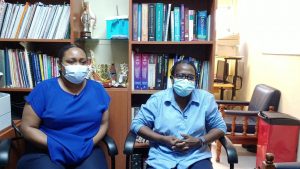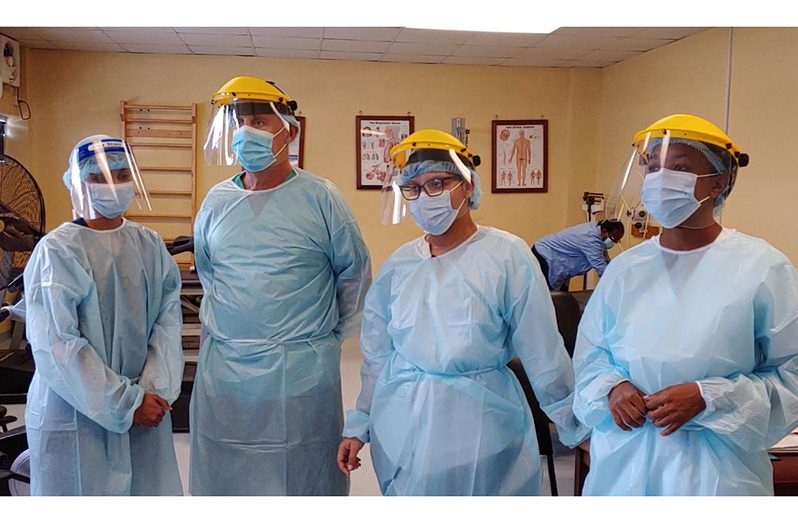By Lisa Hamilton
PHYSIOTHERAPY is a hands-on job. However, the emergence of COVID-19 has changed the way that physiotherapists in Guyana bring needed rehabilitation to patients countrywide. Today, the world celebrates World Physiotherapy Day amidst the COVID-19 pandemic and the Guyana Chronicle visited the Guyana Public Hospital Corporation (GPHC) to get a first-hand view of how things have changed.
“In the Department, the load is not as before because, due to the COVID-19, patients are afraid to come to the hospital if they’re getting a little knee pain or a little back pain. So, we’ve divided up these patients who are afraid to come and we do telemedicine where we send pictures to them, showing them exercises. Those who want to come into us – maybe their case is more complex and can’t be managed through telemedicine – [can do so],” Senior Physiotherapist, Simone Seckle said.

However, with telemedicine comes the challenge of dealing with connectivity issues, patients’ limited access to the internet and the elderly who may not be tech-savvy. Seckle said that while, in other countries, telemedicine is mainly practised through video calls, Guyana’s effort has been somewhat tweaked to suit its challenges.
“What we do is, instead, is send pictures via Whatsapp showing them the exercises on an exercise sheet and then we use the telephone whereby we call and check to ensure that they do the exercises and encourage them,” she said.
Seated next to Seckle during the interview was Principal Physiotherapist (ag), Beverly Nelson. She pointed out that while physiotherapists are accustomed to being close to patients as they assist with their exercises, Personal Protective Equipment (PPE) now ensures a needed barrier in between.
“Before COVID-19, we just came to work. We just did everything we had to do, maybe at times we would use a glove. But now we have to be so careful that we have to use all the PPE available, from headcovers, face-masks, face shields, gowns, gloves and shoe covers in the wards. [In the Department] we would use a face mask, a face shield and glove,” Seckle said.
Before a physiotherapy patients visit the hospital, they are subjected to a questionnaire on whether they are experiencing any of the symptoms of the virus, whether they have recently been to high-risk areas and whether they have been in contact with anyone with the virus. When this is complete, a date is given for them to visit the hospital and, upon their arrival, screening is done.
The women noted that the number of persons visiting the department was “significantly less”. The Department deals with in-patients from all wards and out-patients who come in with trauma injuries. In August, they dealt with some 500 in-patients referred for physiotherapy. In general, they see mainly the elderly and the middle-aged.
TAKING ALL PRECAUTION
Since May 6, 2020, the Physiotherapy Department was tasked with going into the COVID-19 Intensive Care Unit (ICU) and has seen over 56 new patients. Patients in the ICU, showing severely worsened conditions, are usually on a ventilator or an oxygen mask. Seckle outlined: “In this Unit we do mainly respiratory physiotherapy and we will also ensure that they would be mobile. Even though they’re in bed, we do a lot of mobilization exercises.”
Junior Physiotherapist at the GPHC, Stephanie Pires, is among several others working with many bed-ridden patients who cannot move and breathe well. When dealing with patients she understands the need for precaution. “We treat every patient as a possible COVID-19 patient. There are a lot of patients now with coughing and fevers so we have to be very careful when we’re working with each patient because this is a very hands-on profession,” she said.
Meanwhile, Dr. Ernesto Gonzalez, Senior Physiotherapist and Supervisor at the GPHC said that physiotherapists were trying their best to work at the side of or behind patients displaying symptoms. “Sometimes we take the patients to get sunlight which is very important for a patient with COVID-19. We are here as healthcare professionals so we try to save lives,” he said.
MENTAL HEALTH MATTERS TOO

In her work in the Department, Nelson deals with more complex cases related to post-surgery patients with many coming in in need of shoulder-related rehabilitation, rotator cuff injuries and tears. It involves a lot of exercise and patients usually require a lot of encouragement to get through it.
“It’s not a case of just telling them to do their exercise and just leaving them, you actually have to see them go through the exercise, encourage them and motivate them,” she said, noting that some patients can even go into depression. The Principal Physiotherapist (ag) recommended that a clinical psychologist be placed in the department as most physiotherapists are not trained or certified in the area.
When it comes to dealing with children, who usually come in for a fractured arm or leg, physiotherapists must be more engaging to keep their attention. Asked what makes physiotherapy important, Nelson said: “…it helps that individual to get back to his/her previous level of functioning based on what his/her condition is. I think we don’t realise how important it is until there is an injury to an arm or leg and then we realise how important each part of the body is.”
IT’S A FULFILLING JOB
Meanwhile, Seckle said that physiotherapy helps to speed up discharges from the hospital making more beds available to sick patients and can speed up the healing process. She recommends that an extension be made to the Department to cater for new physiotherapists and more patients.
Riet Amsterdam, another junior physiotherapist, said that she feels happiest on the job when she can see the end result of patients who have successfully passed through physiotherapy. Telling of a patient experience, she said: “For the first time when I saw the patient he was just on the bed, he couldn’t do anything for himself and then, of recent, I was in another ward and then I saw him he was like ‘you know I’m getting discharged today!’ He’s now walking and he’s doing things for himself, so that brought a joy and a zest in me.”
Adding her input, Junior Physiotherapist, Belicia Boodram, said that Guyana needs more physiotherapists to help more Guyanese to regain their independence.
World Physiotherapy Day is celebrated annually on September 8. This day serves as an occasion for physiotherapists around the world to stand together in cohesion and solidarity to raise awareness about the profession and the impact it has on helping people achieve optimum functionality. The theme for World Physiotherapy Day 2020 is ‘Rehabilitation After COVID-19’.




.png)









